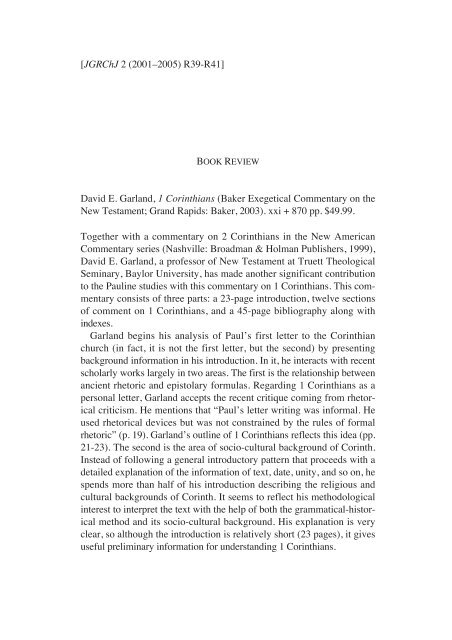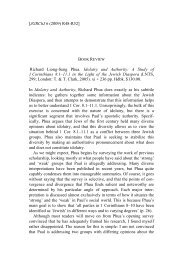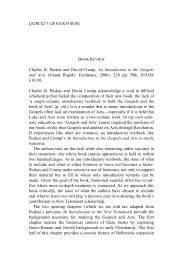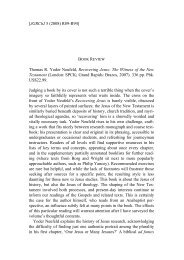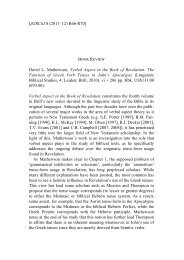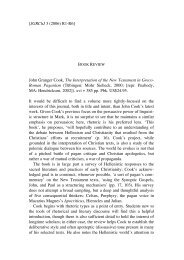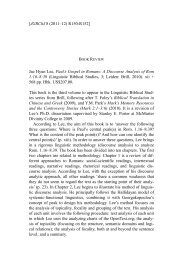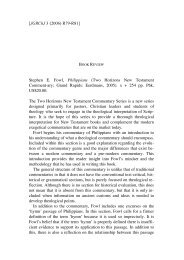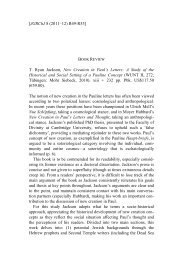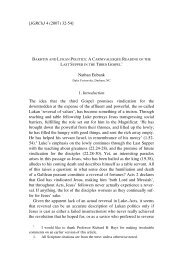David E. Garland, 1 Corinthians Baker Exegetical Commentary on ...
David E. Garland, 1 Corinthians Baker Exegetical Commentary on ...
David E. Garland, 1 Corinthians Baker Exegetical Commentary on ...
Create successful ePaper yourself
Turn your PDF publications into a flip-book with our unique Google optimized e-Paper software.
[JGRChJ 2 (2001–2005) R39-R41]<br />
BOOK REVIEW<br />
<str<strong>on</strong>g>David</str<strong>on</strong>g> E. <str<strong>on</strong>g>Garland</str<strong>on</strong>g>, 1 <str<strong>on</strong>g>Corinthians</str<strong>on</strong>g> (<str<strong>on</strong>g>Baker</str<strong>on</strong>g> <str<strong>on</strong>g>Exegetical</str<strong>on</strong>g> <str<strong>on</strong>g>Commentary</str<strong>on</strong>g> <strong>on</strong> the<br />
New Testament; Grand Rapids: <str<strong>on</strong>g>Baker</str<strong>on</strong>g>, 2003). xxi + 870 pp. $49.99.<br />
Together with a commentary <strong>on</strong> 2 <str<strong>on</strong>g>Corinthians</str<strong>on</strong>g> in the New American<br />
<str<strong>on</strong>g>Commentary</str<strong>on</strong>g> series (Nashville: Broadman & Holman Publishers, 1999),<br />
<str<strong>on</strong>g>David</str<strong>on</strong>g> E. <str<strong>on</strong>g>Garland</str<strong>on</strong>g>, a professor of New Testament at Truett Theological<br />
Seminary, Baylor University, has made another significant c<strong>on</strong>tributi<strong>on</strong><br />
to the Pauline studies with this commentary <strong>on</strong> 1 <str<strong>on</strong>g>Corinthians</str<strong>on</strong>g>. This commentary<br />
c<strong>on</strong>sists of three parts: a 23-page introducti<strong>on</strong>, twelve secti<strong>on</strong>s<br />
of comment <strong>on</strong> 1 <str<strong>on</strong>g>Corinthians</str<strong>on</strong>g>, and a 45-page bibliography al<strong>on</strong>g with<br />
indexes.<br />
<str<strong>on</strong>g>Garland</str<strong>on</strong>g> begins his analysis of Paul’s first letter to the Corinthian<br />
church (in fact, it is not the first letter, but the sec<strong>on</strong>d) by presenting<br />
background informati<strong>on</strong> in his introducti<strong>on</strong>. In it, he interacts with recent<br />
scholarly works largely in two areas. The first is the relati<strong>on</strong>ship between<br />
ancient rhetoric and epistolary formulas. Regarding 1 <str<strong>on</strong>g>Corinthians</str<strong>on</strong>g> as a<br />
pers<strong>on</strong>al letter, <str<strong>on</strong>g>Garland</str<strong>on</strong>g> accepts the recent critique coming from rhetorical<br />
criticism. He menti<strong>on</strong>s that “Paul’s letter writing was informal. He<br />
used rhetorical devices but was not c<strong>on</strong>strained by the rules of formal<br />
rhetoric” (p. 19). <str<strong>on</strong>g>Garland</str<strong>on</strong>g>’s outline of 1 <str<strong>on</strong>g>Corinthians</str<strong>on</strong>g> reflects this idea (pp.<br />
21-23). The sec<strong>on</strong>d is the area of socio-cultural background of Corinth.<br />
Instead of following a general introductory pattern that proceeds with a<br />
detailed explanati<strong>on</strong> of the informati<strong>on</strong> of text, date, unity, and so <strong>on</strong>, he<br />
spends more than half of his introducti<strong>on</strong> describing the religious and<br />
cultural backgrounds of Corinth. It seems to reflect his methodological<br />
interest to interpret the text with the help of both the grammatical-historical<br />
method and its socio-cultural background. His explanati<strong>on</strong> is very<br />
clear, so although the introducti<strong>on</strong> is relatively short (23 pages), it gives<br />
useful preliminary informati<strong>on</strong> for understanding 1 <str<strong>on</strong>g>Corinthians</str<strong>on</strong>g>.
R40 Journal of Greco-Roman Christianity and Judaism 2<br />
After the introducti<strong>on</strong>, <str<strong>on</strong>g>Garland</str<strong>on</strong>g> proceeds with detailed exegesis of the<br />
text. The exegetical part has several merits. First, its overall design is<br />
reader-friendly. As in the other commentaries of the <str<strong>on</strong>g>Baker</str<strong>on</strong>g> <str<strong>on</strong>g>Exegetical</str<strong>on</strong>g><br />
<str<strong>on</strong>g>Commentary</str<strong>on</strong>g> series, <str<strong>on</strong>g>Garland</str<strong>on</strong>g>’s commentary offers overviews and outlines<br />
with short practical expositi<strong>on</strong>s at the outset of each pericope in<br />
gray color. This commentary also indicates where the reader is by the<br />
headings in the top margin of each page. In additi<strong>on</strong>, the flow of explanati<strong>on</strong><br />
in each secti<strong>on</strong> is not interrupted because the text-critical and<br />
grammatical matters are gathered in separate additi<strong>on</strong>al notes. These<br />
three things allow the reader to see the c<strong>on</strong>tents more easily and clearly.<br />
Sec<strong>on</strong>dly, as far as his exegesis is c<strong>on</strong>cerned, he does not engage in a<br />
strict verse-by-verse exegesis; rather, he unfolds the meaning of the text<br />
mainly paragraph-by-paragraph. Sometimes, it may be bothersome if the<br />
reader wants to know the meaning of a certain verse. However, the<br />
verse-by-verse or word-by-word approach fails to show what each word<br />
or verse means in relati<strong>on</strong> to the larger textual c<strong>on</strong>text (co-text). Thus,<br />
<str<strong>on</strong>g>Garland</str<strong>on</strong>g>’s approach presents much help to the reader in understanding<br />
the passage not <strong>on</strong>ly by providing the meaning of an individual verse,<br />
but also by depicting the relati<strong>on</strong>ship within the immediate textual c<strong>on</strong>text.<br />
Besides, his treatment of the passage paragraph-by-paragraph is<br />
c<strong>on</strong>sistent with the outline of each pericope, so it is helpful for the reader<br />
to follow the author’s explanati<strong>on</strong> of the text.<br />
As shown in the introducti<strong>on</strong>, his apparent methodological interest in<br />
combining a grammatical-historical and socio-cultural approach is well<br />
disclosed throughout his analysis of the text. For example, in dealing<br />
with 1 Cor. 14.33b-35, <strong>on</strong>e of the debated passages in 1 <str<strong>on</strong>g>Corinthians</str<strong>on</strong>g>, he<br />
interacts fully with recent archaeological evidence and socio-cultural data<br />
to understand its complicati<strong>on</strong>s (pp. 664-73, 675-77).<br />
Sometimes, however, <str<strong>on</strong>g>Garland</str<strong>on</strong>g> seems to give the impressi<strong>on</strong> that he<br />
deduces his c<strong>on</strong>clusi<strong>on</strong> not from analyzing the text per se but from<br />
scholars’ opini<strong>on</strong>s <strong>on</strong> certain issues. For example, in the above menti<strong>on</strong>ed<br />
case of 1 Cor. 14.33b-35, he begins with a survey and critique of<br />
two other views <strong>on</strong> this problem: interpolati<strong>on</strong> and Corinthian quotati<strong>on</strong>.<br />
Then, he menti<strong>on</strong>s another interpretati<strong>on</strong> as his favourite: it is a matter of<br />
c<strong>on</strong>servati<strong>on</strong> of social c<strong>on</strong>venti<strong>on</strong>. From this perspective, he explains the<br />
c<strong>on</strong>tents of the passage and c<strong>on</strong>cludes that “Paul’s instructi<strong>on</strong>s are c<strong>on</strong>diti<strong>on</strong>ed<br />
by the social realities of his age and a desire to prevent a serious<br />
breach in decorum” (p. 673). In comparis<strong>on</strong> to <str<strong>on</strong>g>Garland</str<strong>on</strong>g>’s process,<br />
Anth<strong>on</strong>y T. Thiselt<strong>on</strong>’s approach is worth noting. Like <str<strong>on</strong>g>Garland</str<strong>on</strong>g>,
Review: GARLAND 1 <str<strong>on</strong>g>Corinthians</str<strong>on</strong>g><br />
R41<br />
Thiselt<strong>on</strong> begins with a survey of the various views <strong>on</strong> this issue. But<br />
Thiselt<strong>on</strong> does not go directly to other scholars’ views to draw his c<strong>on</strong>clusi<strong>on</strong>.<br />
Rather, he analyzes the text first (pp. 1150-61). As far as 1 Cor.<br />
14.33b-15 is c<strong>on</strong>cerned, both approaches are legitimate, but <str<strong>on</strong>g>Garland</str<strong>on</strong>g>’s<br />
approach reveals some weak points in his reading of 1 Cor. 13.13.<br />
In dealing with 1 Cor. 13.13, <str<strong>on</strong>g>Garland</str<strong>on</strong>g> presents two opini<strong>on</strong>s about<br />
understanding the meaning of nuni; dev: temporal and logical meaning (p.<br />
626). Then, he sets up <strong>on</strong>e perspective (logical meaning) and gives three<br />
sorts of evidence for it (p. 626). Here, also, his approach differs from<br />
Thiselt<strong>on</strong>’s (pp. 1071-74). Moreover, his three-fold evidence is not c<strong>on</strong>vincing.<br />
First, he cites the appearance of mevnei in 1 Esd. 4.38 as a supporting<br />
example of mevnei in 1 Cor. 13.13 (p. 626 n. 18). However, it is<br />
questi<strong>on</strong>able in what sense the usage in 1 Esd. 4.38 can be supporting<br />
evidence for that in 1 Cor. 13.13. Is it just because of the same word?<br />
Sec<strong>on</strong>dly, he thinks that because the other two occurrences of nuni; dev<br />
(12.18; 15.20) have the logical sense, then 1 Cor. 13.13 also has a logical<br />
meaning. However, he does not c<strong>on</strong>sider the differences of co-text<br />
between them. The occurrences in 12.18 and 15.20 apparently have the<br />
logical sense because their immediate textual c<strong>on</strong>texts do not have any<br />
temporal situati<strong>on</strong>. However, the co-text of 1 Cor. 13.13 has a clear temporal<br />
c<strong>on</strong>trast between present and future (1 Cor. 13.8-12). Thus, his<br />
sec<strong>on</strong>d evidence is not adequate because he uses it without c<strong>on</strong>sidering<br />
the importance of the co-text. Thirdly, he lists the c<strong>on</strong>trasts between ‘the<br />
triad of prophecy, knowledge, and t<strong>on</strong>gues’ and ‘the triad of faith, hope,<br />
and love’ as another evidence for the logical sense of nuni; dev. But, it is<br />
also doubtful in what sense they are in c<strong>on</strong>trast. Moreover, there is no<br />
co-textual evidence of this kind of c<strong>on</strong>trast. Thus, Thiselt<strong>on</strong>’s suggesti<strong>on</strong><br />
is correct: ‘if nuni; de; mevnei means “taking all into account,” Paul does<br />
not yet quite part with the importance of faith in the God revealed and<br />
“hope in the ever-growing revelati<strong>on</strong>”’ (p. 1073).<br />
However, the above minor criticisms should not take away from the<br />
overall excellent treatments in this commentary. In general, <str<strong>on</strong>g>Garland</str<strong>on</strong>g> provides<br />
well-balanced informati<strong>on</strong> from recent scholarly sources and<br />
ancient socio-cultural sources, and uses them to interpret the complex<br />
issues with clarity and readability. His commentary deserves to be <strong>on</strong>e of<br />
the first references in studying Paul’s first letter to the <str<strong>on</strong>g>Corinthians</str<strong>on</strong>g>.<br />
Jae Hyun Lee<br />
McMaster Divinity College


